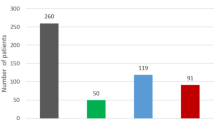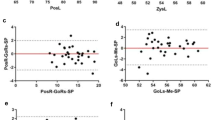Abstract
Shape analysis of infant’s heads is crucial to diagnose cranial deformities and evaluate head growth. Currently available 3D imaging systems can be used to create 3D head models, promoting the clinical practice for head evaluation. However, manual analysis of 3D shapes is difficult and operator-dependent, causing inaccuracies in the analysis. This study aims to validate an automatic landmark detection method for head shape analysis. The detection results were compared with manual analysis in three levels: (1) distance error of landmarks; (2) accuracy of standard cranial measurements, namely cephalic ratio (CR), cranial vault asymmetry index (CVAI), and overall symmetry ratio (OSR); and (3) accuracy of the final diagnosis of cranial deformities. For each level, the intra- and interobserver variability was also studied by comparing manual landmark settings. High landmark detection accuracy was achieved by the method in 166 head models. A very strong agreement with manual analysis for the cranial measurements was also obtained, with intraclass correlation coefficients of 0.997, 0.961, and 0.771 for the CR, CVAI, and OSR. 91% agreement with manual analysis was achieved in the diagnosis of cranial deformities. Considering its high accuracy and reliability in different evaluation levels, the method showed to be feasible for use in clinical practice for head shape analysis.
Graphical Abstract












Similar content being viewed by others
References
Aarnivala, H., et al. Accuracy of measurements used to quantify cranial asymmetry in deformational plagiocephaly. J. Cranio-Maxillofac. Surg. 45(8):1349–1356, 2017
Beaumont, C. A. A., et al. Three-dimensional surface scanners compared with standard anthropometric measurements for head shape. J. Cranio-Maxillofac. Surg. 45(6):921–927, 2017
Cho, M. J., L. L. Borchert, and A. A. Kane. Diagnostic yield of routine skull radiographs in infants with deformational plagiocephaly. Cleft Palate-Craniofac. J. 54(5):497–501, 2017
Ditthakasem, K., and J. C. Kolar. Deformational plagiocephaly: a review. Pedriatric. Nurs. 43(2):59–65, 2017
Düppe, K., M. Becker, and B. Schönmeyr. Evaluation of facial anthropometry using three-dimensional photogrammetry and direct measuring techniques. J. Craniofac. Surg. 29(5):1245–1251, 2018
Ifflaender, S., M. Rüdiger, A. Koch, and W. Burkhardt. Three-dimensional digital capture of head size in neonates—a method evaluation. PLoS ONE. 8(4):e61274, 2013
Ifflaender, S., M. Rüdiger, D. Konstantelos, K. Wahls, and W. Burkhardt. Early Human Development Prevalence of head deformities in preterm infants at term equivalent age ☆. Early Hum. Dev. 89:1041–1047, 2013
Kunz, F., et al. Subjective perception of craniofacial growth asymmetries in patients with deformational plagiocephaly. Clin. Oral Investig. 25(2):525–537, 2021
Leung, A., P. Watter, and J. Gavranich. A clinical tool to measure plagiocephaly in infants using a flexicurve: a reliability study. Pediatr. Heal. Med. Ther. 2013. https://doi.org/10.2147/PHMT.S48864
Martiniuk, A. L. C., C. Vujovich-Dunn, M. Park, W. Yu, and B. R. Lucas. Plagiocephaly and developmental delay: a systematic review. J. Dev. Behav. Pediatr. 38(1):67–78, 2017
Meulstee, J. W., et al. A new method for three-dimensional evaluation of the cranial shape and the automatic identification of craniosynostosis using 3D stereophotogrammetry. Int. J. Oral Maxillofac. Surg. 46(7):819–826, 2017
Meulstee, J. W., G. A. de Jong, W. A. Borstlap, G. Koerts, T. J. J. Maal, and H. Delye. The normal evolution of the cranium in three dimensions. Int. J. Oral Maxillofac. Surg. 49(6):739–749, 2020
Meyer-Marcotty, P., et al. Head orthesis therapy in infants with unilateral positional plagiocephaly: an interdisciplinary approach to broadening the range of orthodontic treatment. J. Orofac. Orthop. 73(2):151–165, 2012
Meyer-Marcotty, P., H. Böhm, C. Linz, J. Kochel, A. Stellzig-Eisenhauer, and T. Schweitzer. Three-dimensional analysis of cranial growth from 6 to 12 months of age. Eur. J. Orthod. 36(5):489–496, 2014
Miller, R. I., and S. K. Clarren. Long-term developmental outcomes in patients with deformational plagiocephaly. Pediatrics. 105(2):e26–e26, 2000
Mortenson, P. A., and P. Steinbok. Quantifying positional plagiocephaly: reliability and validity of anthropometric measurements. J. Craniofac. Surg. 17(3):413–419, 2006
Nahles, S., M. Klein, A. Yacoub, and J. Neyer. Evaluation of positional plagiocephaly: conventional anthropometric measurement versus laser scanning method. J. Cranio-Maxillofac. Surg. 46(1):11–21, 2018
Oliveira, B., et al., Automatic strategy for extraction of anthropometric measurements for the diagnostic and evaluation of deformational plagiocephaly from infant’s head models. In: SPIE Medical Imaging. International Society for Optics and Photonics, 2019, p. 9.
Porras, A. R., et al. Quantification of head shape from three-dimensional photography for presurgical and postsurgical evaluation of craniosynostosis. Plast. Reconstr. Surg. 144(6):1051e–1060e, 2019
Di Rocco, F., V. Ble, P. A. Beuriat, A. Szathmari, L. N. Lohkamp, and C. Mottolese. Prevalence and severity of positional plagiocephaly in children and adolescents. Acta Neurochir. (Wien). 161(6):1095–1098, 2019
Rogers, G. F. Deformational plagiocephaly, brachycephaly, and scaphocephaly. Part I: terminology, diagnosis, and etiopathogenesis. J. Craniofac. Surg. 22(1):9–16, 2011
Schaaf, H., J. F. Wilbrand, R. H. Boedeker, and H. P. Howaldt. Accuracy of photographic assessment compared with standard anthropometric measurements in nonsynostotic cranial deformities. Cleft Palate-Craniofac. J. 47(5):447–453, 2010
Skolnick, G. B., S. D. Naidoo, D. C. Nguyen, K. B. Patel, and A. S. Woo. Comparison of direct and digital measures of cranial vault asymmetry for assessment of plagiocephaly. J. Craniofac. Surg. 26(6):1900–1903, 2015
Torres, H. R., et al. Anthropometric landmark detection in 3D head surfaces using a deep learning approach. IEEE J. Biomed. Heal. Inform. 2194:1–1, 2020
Torres, H. R., et al. Deep Learning-based detection of anthropometric landmarks in 3D infants head models. In: SPIE Medical Imaging (2019).
Torres, H. R., et al. 3D Facial Landmark Localization for cephalometric analysis [in press]. In: IEEE Engineering in Medicine and Biology Society (EMBC’22) (2022).
Weinberg, S. M., S. Naidoo, D. P. Govier, R. A. Martin, A. A. Kane, and M. L. Marazita. Anthropometric precision and accuracy of digital three-dimensional photogrammetry: comparing the genex and 3dMD imaging systems with one another and with direct anthropometry. J. Craniofac. Surg. 17(3):477–483, 2006
Wilbrand, J. F., et al. Clinical classification of infant nonsynostotic cranial deformity. J. Pediatr. 161(6):1120-1125.e1, 2012
Willis, S., R. Hsiao, R. A. Holland, K. Lee, and K. Pitetti. Measuring for nonsynostotic head deformities in preterm infants during NICU management: a pilot study. Early Hum. Dev. 131:56–62, 2019
Wong, J. Y., et al. Validity and reliability of craniofacial anthropometric measurement of 3D digital photogrammetric images. Cleft Palate-Craniofac. J. 45(3):232–239, 2008
Acknowledgments
This work was funded by projects “NORTE-01-0145-FEDER-000045” and “NORTE-01-0145-FEDER-000059”, supported by Northern Portugal Regional Operational Programme (Norte2020), under the Portugal 2020 Partnership Agreement, through the European Regional Development Fund (FEDER). This project was also funded by national funds (PIDDAC), through the FCT – Fundação para a Ciência e Tecnologia and FCT/MCTES under the scope of the projects UIDB/05549/2020, UIDP/05549/2020 and Lasi-LA/P/0104/2020. The authors also acknowledge support from FCT and the European Social Found, through Programa Operacional Capital Humano (POCH), in the scope of the PhD grant SFRH/BD/136670/2018, SFRH/BD/136721/2018, and SFRH/BD/131545/2017.
Conflict of interest
The authors declare no conflict of interest.
Author information
Authors and Affiliations
Corresponding author
Additional information
Associate Editor Ka-Wai Kwok oversaw the review of this article.
Publisher's Note
Springer Nature remains neutral with regard to jurisdictional claims in published maps and institutional affiliations.
Rights and permissions
About this article
Cite this article
Torres, H.R., Morais, P., Fritze, A. et al. Anthropometric Landmarking for Diagnosis of Cranial Deformities: Validation of an Automatic Approach and Comparison with Intra- and Interobserver Variability. Ann Biomed Eng 50, 1022–1037 (2022). https://doi.org/10.1007/s10439-022-02981-6
Received:
Accepted:
Published:
Issue Date:
DOI: https://doi.org/10.1007/s10439-022-02981-6




